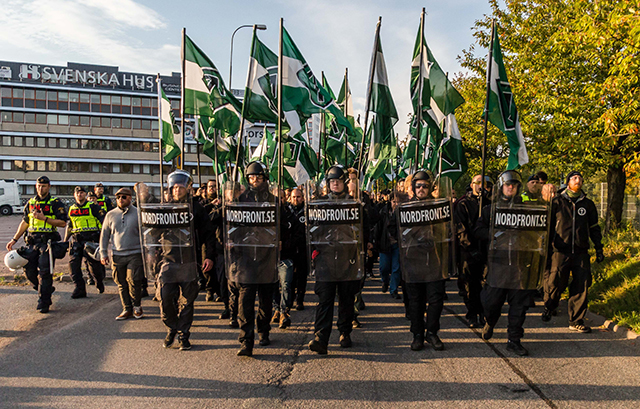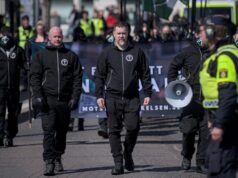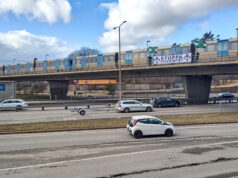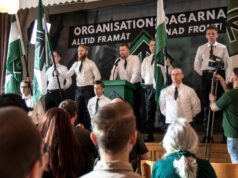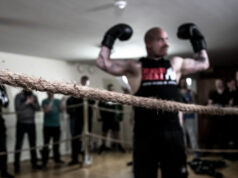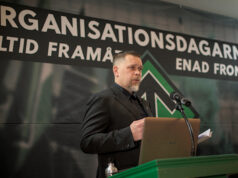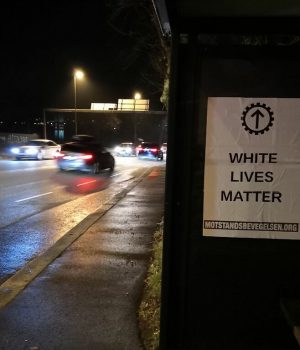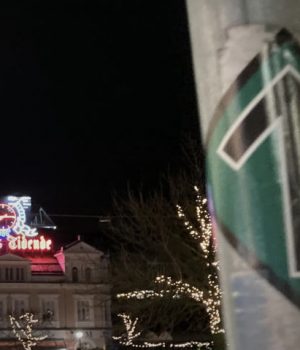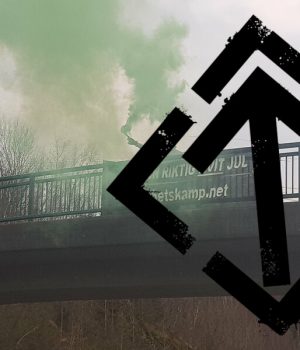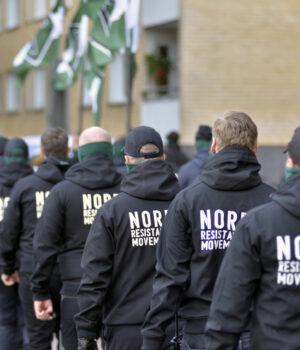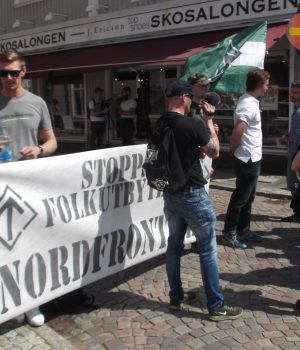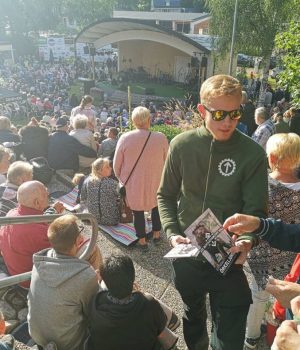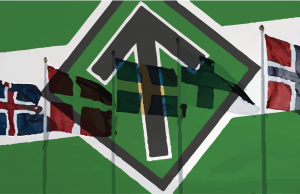RESISTANCE NEWS. All Resistance men involved in the opinion trial in Gothenburg have been acquitted of all charges of ”hate speech”. Meanwhile, five people were sentenced for violent rioting.
On October 25 a roughly 100-page-long verdict was passed against 16 participants in the demonstration organized by the Nordic Resistance Movement in Gothenburg on September 30 2017. The prosecutor Jonas ”Sleepy Joe” Martinsson tried to claim that the participants ”together and in concert” committed the crime of hate speech. Some were also charged for rioting after a confrontation with the violent police.
It is now clear that none of the accused will be sentenced for ”hate speech”. The Crown Court of Gothenburg also said it was not proven that the Tyr rune is associated with the Third Reich in such a way to render it comparable to symbols such as the swastika.
One of the five people sentenced for violent rioting will receive a prison sentence of two months. The rest will be on probation and will have to perform community service. Meanwhile Jimmy Andersson was entirely acquitted of the charge of violent rioting, despite the prosecutor claiming he was the leader of the riot.
The Crown Court was critical of the material used as evidence, including heavily edited video footage without timestamps that was used against Andersson in particular:
The prosecutor’s evidence includes a number of videos. It has emerged that a large amount of film material was examined. From this material the police’s IT forensics made a compilation in order to show the actual chain of events from beginning to end. Since we are dealing with compiled material, it follows that it cannot reflect all the details during the actual events.
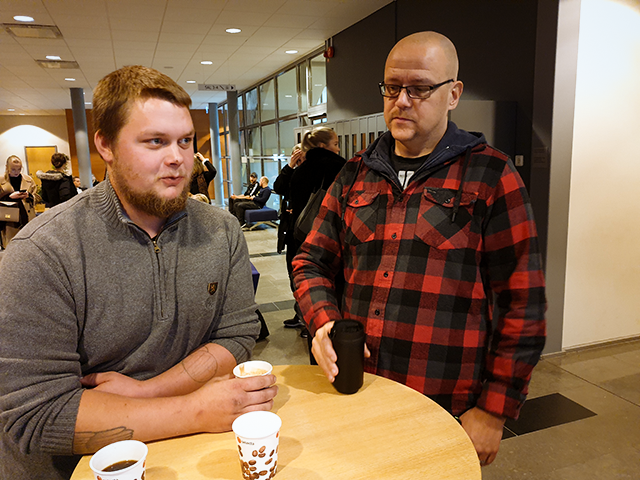
However, it was also claimed that the film footage, combined with testimonies, gave ”a relatively good picture of the chain of events in general and in regard to what is decisively important in judging this prosecution”.
In the case of Jimmy Andersson, which became a hot topic during the trial, they write:
What can be observed is that the same chain of events is shown several times from different camera angles, which could easily give you the impression that we are dealing with a longer chain of events than one lasting only one or a few minutes. The film footage, when this is taken into consideration, does not lend credence to the idea that the violent riot went on for more than a single minute, the Crown Court says. In the video Jimmy Andersson is seen summoning shield bearers via radio and then telling them to take one step forward. Through witness interrogations, with Jörgen Olsson and Jonas Lindstedt, it has been established that a significantly larger amount of time passed between these different events than the video suggests.
As such it was concluded that the prosecutor did not manage to prove that Andersson either took part in the riot or commanded it.
The entire hate speech section is rejected
In the verdict the Crown Court gave a long exposition regarding the section of the prosecution concerning “hate speech”, in which it was concluded that the jackets, shields and placards that, according to the prosecution, were props in the opinion crime are in fact covered by the Freedom of the Press Act and are therefore a case for the Chancellor of Justice – a government agency that has already decided the Tyr rune is completely legal.
But it was noted that the prosecutor did not ask the court to examine the printed messages; for example, the Tyr rune, but rather how they are used “in concert” by demonstrators in order to express contempt “for other ethnic groups apart from the Nordic”.
In its argument, the court quoted both the Swedish constitution and the European Convention on Human Rights, which guarantee Swedish citizens freedom of speech. It also wrote that freedom of speech is one of “the founding pillars of democracy” and cited the European Convention on Human Rights:
Freedom of speech is one of the essential foundations for a [democratic] society, one of the fundamental preconditions for these advances and for the evolution of every human being. It does not only encompass information and ideas received positively or considered harmless but also those that offend, shock or disturb the state or any part of the population.
The court also said the fact that this was a constitutionally protected demonstration weakens the prosecutor’s argument that the usage of the symbols ought to be a criminal offence:
As the Crown Court has previously established in regard to the Press Act, there is limited scope to judge the usage of these items as hate speech. Judging by the context – a political demonstration arranged by the NRM – the Crown Court has come to the conclusion that using these items in and of themselves does not constitute hate speech.
The Crown Court also dismissed the prosecutor’s claim that the uniform dress code was supposed to give a “militaristic impression”. The court did say that the shield bearers have a more uniform dress code than the other participants, but that these are more reminiscent of riot police than any military personnel and that the equipment is obviously used to protect demonstrators from police, counter demonstrators, and journalists wishing to photograph the participants.
“The Crown Court has come to the conclusion that the cumulative impression of the demonstrators overall, including the equipment and impressions of the shield bearers, is not militaristic, nor that it is unambiguously connected to the National Socialist opinions during the 1930s and 1940s in Germany. This behaviour, taken in isolation, is not to be considered hate speech,” the court established.
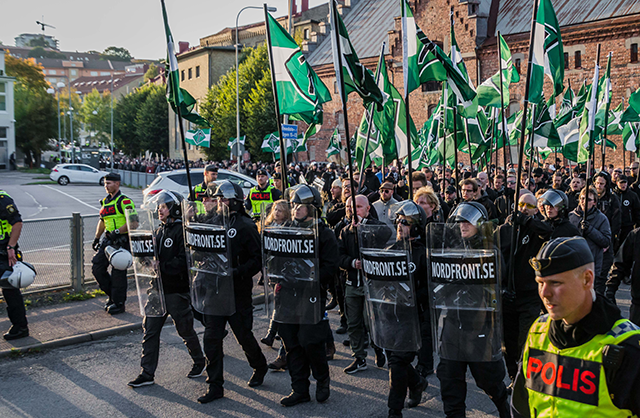
Regarding the Tyr rune, the Crown Court admitted it has been used to some extent by National Socialists during the Third Reich, but that “it has had a long history before the 20th century, and that, according to footage shown in this proceeding, is still used in completely different contexts than the one we are dealing with”.
The court also referenced the decision of the Chancellor of Justice that the Tyr rune does not constitute hate speech in the way the prosecutor claims.
The court said it had been established that more than one person shouted “Hail victory!” but also claimed there is nothing indicating that any of the accused shouted it. It did not seem like some coordinated and rehearsed exclamation, but rather as “shouts erupting spontaneously in an excited and tumultuous situation in what is described as a violent riot”.
Fredrik Vejdeland’s speech
The prosecutor claimed that Fredrik Vejdeland‘s speech singled out “these people” – whose faces were seen on placards during the demonstration under the designation of “criminals” – as responsible for folk treason and genocide against the Nordic people due to mass immigration, and that this constituted “hate speech” because some of these people are Jews.
But the Crown Court said that the “collective impression of the placards and the persons displayed on the placards are rather representatives of what could be called the Swedish establishment or rulers, rather than representatives of any particular group of people with reference to racial, ethnic or religious origins” and that “politicians, officials and journalists are not a protected group of people according to chapter 16 section 8 of the criminal code”. As such they dismissed the claims of the prosecutor.
The prosecutor also claimed that Vejdeland’s remarks about treason and crimes being based on the idea that the rulers have orchestrated mass immigration should constitute hate speech. But the Crown Court writes the following about this:
It is doubtful whether Fredrik Vejdeland’s remarks are directed against a certain ethnic group or group of persons in the sense required by the penalty clause. He directs, as has been demonstrated above, his remarks against the rulers who he thinks are responsible for the wrongs of society, and reconnects it to the slogan of the demonstration, which was “revolt against the criminals”. Even if his remarks would be found to be directed against any particular group of people, the Crown Court thinks, taking the judicial aspects of freedom of speech into consideration, that his remarks do not reach such a level of disdain demanded of them to be regarded as hate speech in and of themselves.
Was the demonstration reminiscent of 1930s Germany?
At the end of the verdict, the Crown Court argued as to whether the aesthetics of the demonstration were so similar to 1930s and 1940s Germany that those who participated in it were guilty of hate speech via some sort of mutual understanding.
The Crown Court did not agree with this claim:
The collective behaviour which is about to be tried is far away from the events that appeared in the earlier decisions. It’s not a matter of a uniform dress code that has an unambiguous similarity with the dress code of Nazis in Germany during the 1930s and 1940s. That some of the demonstrators wore uniform jackets, and that flags and placards have been carried, does not make this different from other political demonstrations in the view of the Crown Court. It’s not a demonstration with a slogan intended to be perceived as pro-Nazi in itself, and the demonstrators have not acted in a way that unambiguously makes one think of Nazism of the 1930s and 1940s.
As such, all people involved were acquitted of the charge of hate speech.
Are the Nordic Resistance Movement’s views criminal?
Critiques of the prosecutor’s arguments are presented in several places in the verdict. The prosecutor tried to claim the political views of the Nordic Resistance Movement are criminal in and of themselves because the organization is said to advocate “racial superiority”. The prosecutor thus wanted to charge the demonstrators with this, claiming they show sympathy for these “criminal” opinions by participating in the demonstration.
The Crown Court had the following to say about this:
As the Crown Court has also established above, it is not punishable to be a member of the NRM, and it might also be said that it is not punishable to hold the views that the NRM could be said to hold. There is no reason for the Crown Court to determine if the opinions of the NRM, whether in the party program or in other writings, could constitute hate speech, but the Crown Court has to determine if the behaviour on Fabriksgatan September 30 2017, as it has been described in the deed act, constitutes hate speech.
To hold this view, that publicly expressing affiliation or sympathy for the NRM is punishable as hate speech, would be to extend the realm of criminality too far and does not seem in accordance with the constitutionally and conventionally protected principles of freedom of speech and association.
Also the idea of an “expanded crew of accomplices” was in itself rejected. The prosecutor claimed that Fredrik Vejdeland’s speech constituted hate speech, since he criticized those in power and that those listening to his speech were his accomplices. But the Crown Court also writes that even if crimes had been committed, it is not enough just to be at a location in order to be considered an accomplice. Nor is sympathizing with the alleged crime enough in itself for one to be regarded as an accomplice.
“There is no investigation as to whether the individuals accused, in addition to having participated in the demonstration, are regarded as having furthered the deed,” they write.
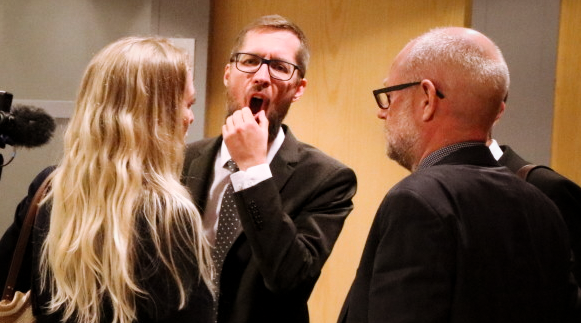
The prosecutor also attempted to charge the demonstrators based on the fact that the Nordic Resistance Movement often keep up with what is legal or not. As support he used the SÄPO analyst Ahn-Za Hagström, who testified that members of the Nordic Resistance Movement often order protocols of preliminary investigations and verdicts in order to adapt to the reality of governing laws and judicial practice.
This reasoning was strongly questioned by several lawyers, who said that it could not be seen as something negative to keep oneself updated on what is legal or not. It should rather be seen as something positive, on which the Crown Court concurs:
In conclusion the Crown Court holds the view that the investigation in this section does not speak especially strongly for the idea that members or sympathizers of the NRM would generally remain indifferent if crimes had been committed, but might just as well indicate the opposite, that at least some of them are anxious to publicly stay on the right side of the legal boundary, something that is generally seen as commendable.
The court rejects the recommendation of the Prison and Probation Service – National Socialists do not need to be locked up
As usual the Probation Service expressed the view that members of the Nordic Resistance Movement are not suitable for community service or probation because the agency has essentially chosen to classify the Movement as a criminal organization.
But the Crown Court chose to go against the recommendations of the Probation Service regarding penalties, claiming it is too generalized:
In this section the Crown Court has established that the judgements do not appear to be individualized, but that the same type of judgement is made regarding everyone. It has not been stated that closer connections to the NRM of an individual or to the White Power environment have been investigated, and to a certain extent it seems as if the prosecuted act in itself acts as the basis for the assessment. Neither has the Probation Service stated what risks of threats and violence we are talking about. It does not seem reasonable that an accused, as a consequence of having participated in a political demonstration for a certain party, should be sentenced with a heavier penalty than otherwise simply for this reason. The Crown Court therefore has concluded that there is no general obstacle to sentencing an accused to probation in combination with community service.
Out of the five people sentenced for violent rioting, four will receive a sentence of probation for two months along with 75 hours of community service. The fifth person will receive a prison sentence of two months since he was convicted of a similar crime not long ago.
Simon Lindberg: “The prosecutors should resign!”
Nordfront spoke to the leader of the Nordic Resistance Movement, Simon Lindberg, who had the following to say about the verdict:
“As we have always said, this was the weakest prosecution that has ever been pursued against us. That we would be acquitted, from a purely judicial perspective, seemed obvious – but that the court would actually dare to go through with this is a completely different matter. The pair of prosecutors should resign immediately.”
Fredrik Vejdeland was also happy about the outcome:
“It was a clear let-down for the system and a major victory for us. A conviction would have meant the system succeeding in banning the use of an ancient Nordic symbol, limiting our demonstration rights and by extension implicitly banning National Socialism. This decision will surely be appealed, but I feel that we already have a huge advantage now we have been acquitted by the judicial system that has essentially always convicted us. Hail v******!”
Vejdeland’s confidence regarding a possible trial by higher courts was also shared by Nils Funcke, an expert on freedom of speech, and Oisín Cantwell, the judiciary columnist for Aftonbladet, who said the verdict was well motivated and indicated how the higher instances will argue matters in the case.
A disappointed prosecutor Martinsson has not yet decided whether to appeal but said it is “likely”.


